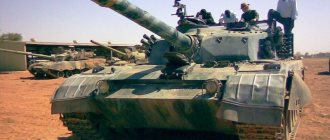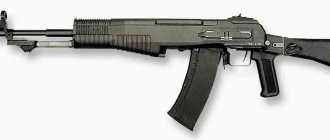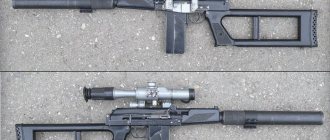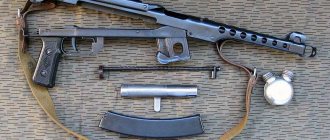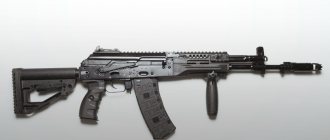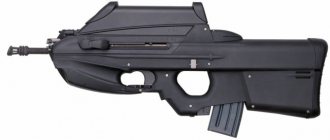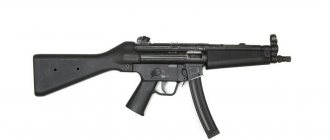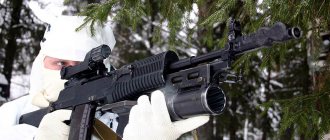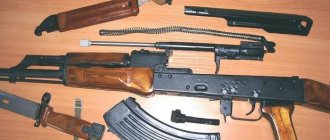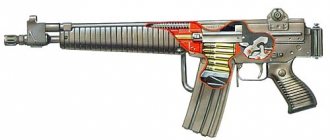The need for a submachine gun, an automatic melee weapon, arose during the First World War. The immediate predecessors of submachine guns were rapid-fire semi-automatic pistols with attached butts. Shortly before the end of the war, the first submachine guns were produced in Germany and Italy, with the German model becoming a classic.
Pistol "Mauser"
The German Mauser pistol model 1895, known as the "military model", was not officially in service anywhere, although many officers purchased it at their own expense. The first releases had a caliber of 7.63 mm, then 9 mm caliber pistols were released under a special Mauser cartridge, and by 1914 many pistols were converted to the 9 mm Parabellum cartridge (the most common type of cartridge). The standard model had an integral ten-round magazine, which was loaded from the top from the clip. Fully automatic Mausers, which were actually light submachine guns, were produced in small quantities.
Automatic "Mauser"
The first submachine guns
In 1915, Italy became the first country to officially adopt a submachine gun, known under the names “Villar Perosa”, or “Fiat” (this depended on the name of the designer Abiel Revelli. There was no stock, the weapon was double-barreled with two box magazines 25 rounds and a trigger. Like other early examples of Italian submachine guns, this weapon fired 9 mm Glisenti cartridges, similar to the 9 mm Parabellum cartridge, but with reduced power. Although the weapon was small, it was mainly used as a heavy machine gun. By 1918 g. Italian soldiers were rearmed with a modified version of this submachine gun, which was produced, and began to use it in offensive operations.
Italian coaxial submachine gun "Villar Perosa". Although this unusual looking weapon is completely different from modern submachine guns, it was in fact the first submachine gun in the world. The Italians were unable to appreciate its potential and used it as a light machine gun.
The German Bergman MP-18 submachine gun, designed by Louis Schmeisser in 1917, embodied many characteristic solutions that would later become standard. The German Army ordered 50,000, and by the time of the known "Kaiserschlacht" ("Imperial Battle") offensive on the Western Front in 1918, had received about 10,000. After the war, stocks of these weapons passed to the French, who replaced the drum-type magazine with 20- or 30-round box magazines flanked on the left; the same magazines were produced after the resumption of production of these submachine guns in Belgium under license in 1928.
The company was supposed to be armed with six MP-18 submachine guns, and each was supposed to be served by a crew of two people - a shooter and an ammunition carrier. However, the First World War ended even before the weapon passed all tests
By the end of the First World War, the Beretta M1918 submachine gun, created by the young talented engineer Tullio Marengoni based on the Villar Perosa submachine gun system, began to be produced in Italy. The weapon now has a trigger, a butt and a chute for spent cartridges, located under the window for ejecting cartridges. In addition, a folding bayonet from a military carbine of the Carcano system was added. The shock units of the Italian army were armed with such weapons.
The Degtyarev submachine gun (PDD) was developed by Russian designer Vasily Alekseevich Degtyarev in 1934 and a year later adopted by the Red Army. It was produced in limited quantities under the designation PPD-34 with a box magazine for 25 rounds. Modified in 1938, until 1939 this submachine gun was produced under the designation PPD-34/38 with a new drum magazine for 71 rounds. Although a new version was developed in 1940 with a two-piece stock and a new 71-round drum magazine, by June 1941 it turned out that the PPD-40 was not designed for mass production under wartime conditions, and it was replaced by a more efficient and cheaper PPSh-41.
The Soviet PPD-34/38 submachine gun was produced at arms factories in Tula and Sestroretsk until 1940, after which it was replaced by the simpler but well-made PPD-40
The French MAC 38 submachine gun appeared in 1938 as a result of refinement of the experimental MAC 35 model and was a good melee weapon, all parts of which were made using milling and turning. The box magazine held 32 rounds, the rate of fire was 600-700 rounds per minute. After the surrender of France in 1940, production at the plant in Saint-Etienne came under the control of the German occupiers, who continued to produce MAC 38 for their own needs until 1944.
The elegant Beretta model 1918 served the Italian army during World War II. A curved box magazine holding 25 rounds was attached to the top. The weapon was equipped with a folding needle bayonet
Read about World War II submachine guns in this article.
After World War II, many countries produced submachine guns, equipping the army and police with them. For many, wartime weapons served as models, but in the calm conditions of peacetime, designs that had stood the test of combat were refined and improved.
The British, to replace the extremely cheap and inaccurate “camp,” developed a very expensive and accurate “sterling” in shooting. The Germans first armed themselves with the Walther MR-K, and then with the Heckler handsome MP 5.
The German MP 5 is one of the most accurate SMGs in the world. It differs from the G 3 rifle only in its pistol chamber and shorter barrel. The MP 5 is not only in service with almost all special forces in the world, but also “fights” a lot on movie screens
The French, after the awkward MAS of 1938, created the MAT 49 with a forward-folding magazine and a retractable butt, like the American “syringe” M 3.
The Italians first acquired a simple Beret M12, and then a more complex and accurate “Spector” M 4. The most revolutionary example of a submachine gun was created by the Czechoslovak designer Jaroslav Holicek in 1948. In his M 48, the bolt ran two-thirds of the way onto the rear of the barrel, which sharply reduced the overall length of the weapon. He inserted the magazine into the pistol grip, and the result was a design for the new PP, which was later repeated in the Israeli Uzi, American Ingram, Spanish Star, Argentine FMK and even in the Austrian MP 69 player.
PM 63 (Poland)
Specter (Italy)
Miroslav Rybar created his small-sized Scorpion SMG for Czech tankers and special forces. But, as often happens, due to the possibility of concealed carrying, his submachine gun became the favorite weapon of all kinds of terrorists, including our country.
Scorpion (Czech Republic)
To fight terrorists, we had to create both special forces and submachine guns, which are indispensable in such cases. The first of them were PP “cedar” and “cypress” with magazines from 10 to 30 rounds. Due to the worsening crime situation, our soldiers had to arm themselves with a real “buffalo” with an auger magazine for as many as 64 pistol cartridges!
OTs-02 “cypress” (Russia)
PP-19 "bizon" (Russia)
"Kashtan" (Russia)
Pretense
Quote
- Mos 2022, pp. 41–44.
- Mos 2022, pp. 38–41.
- "Contre les Mau Mau". Encyclopédie des armes: Les forces armées du monde
(in Frensky ezik).
XII
. Atlas. 1986. p. 2764–2766. - ^ a b
Mos 2022, p. 46. - Perez, Jean-Claude (March 1992). “Les armes de l'OAS” Gazette des Armes
(in French language). No. 220. p. 28–30. Archived from the original on 10/08/2018. Revised 2018-10-08. - Mos 2022, pp. 49–51.
- Mos 2022, p. 47.
- "Arms for freedom." December 29, 2022. Expired 2019-08-31.
- ^ a b ° C
Mos 2022, p. 73. - Jowett, Philip (2016). Contemporary African Wars (5): The Nigerian-Biafrica War 1967–70
. Oxford: Osprey Publishing Press. pp. 19 and 43. ISBN 978-1472816092. - ^ a b ° C
Mos 2022, p. 65. - Mos 2022, pp. 51–52.
- ^ a b
Rothman, Gorden L. (1993).
Armies from the war in the Persian Gulf
. Elite 45. Osprey Publishing. pp. ISBN 9781855322776. - Alpeyri, Jonathan. .
- Prouchvane na malkite orzhia (2012). “Trained on the battlefield: Illegal entry into Afghanistan, Iraq and Somalia” (PDF). Study on Malkite Orzhia 2012: moving all the goals
. Cambridge University Press. p. 321. ISBN 978-0-521-19714-4. Archived from the original on 2018-08-31. Revised 2018-08-30. - ^ a b
Jenzen-Jones, N.R.;
McCollum, Ian (April 2022). Prouchvane na malkite orzhia (ed.). Traffic in Mrezhata: Analysis of online shopping malls from Malki Orzhia and Leko Orzhia in Libya
(PDF). Worked on document No. 26. p. 95. Archived (PDF) from the original on 2018-10-09. Published 2018-08-30.CS1 maint: ref = harv (vzka) - “Experimental underwater shotgun Patchett 9 mm Mk I, 1944 (c) | Online collection | National Army Museum, London. Nam.ac.uk. Archived from the original on 01/28/2017. Revised 2017-01-28.
- "It packs." firearms orzhia.96.lt
. Archived from the original on July 17, 2022. Revised April 3, 2018. - "FIREARMS CURIOSA, 1942 Patchett Prez carbine car, George William." Augfc.tumblr.com. Archived from the original on 07/13/2015. Revised 2017-01-28.
- Spored by Mathew Mos (Mos 2022, p. 38), “Contrary to a lot of research, there is not a lot of documentary evidence to suggest that the victims of Pachets sa measured the legendary cue ball, which is located in Arnhem.”
- "Orzhia na Pachet." Haulerwijk.com. 2015-04-19. Archived from the original on 02/15/2017. Revised 01/28/2017.
- "Patchett Machine Carbine Mk1 (FIR 6232)". Iwm.org.uk. 1999-02-22. Archived from the original on 07/29/2017. Revised 2017-01-28.
- "Captain P. C. Beckett and Lt. Col. RWP Dawson, DSO., Dekemvri 1945.” Gallery.commandoveterans.org. 08/28/2013. Archived from the original on 08/19/2016. Revised 2017-01-28.
- "Mk1 carbine machine patches (FIR 6365)." Iwm.org.uk. 1999-02-22. Archived from the original on 2018-04-03. Revised 2017-01-28.
- "Patchett 9mm Machine Carbine, Experimental (FIR 6160)." Iwm.org.uk. 2005-06-01. Archived from the original on 07/29/2017. Revised 2017-01-28.
- Rinzler, J. W. (10/22/2013). Sezdavaneto on Interstar Wars
(Approved by the editor). New York: Random House LLC. With. 636–637. ISBN 978-0-345-54286-1. - Fowler, Wil (2009). Royal Marine Commando 1950–82: From Korea to Falkland
. Osprey. pp. 17–20. ISBN 978-1-84603-372-8. - Cutshaw, Charles K. (February 28, 2011). Tactical small arms weapons for the 21st century: Full leadership for small weapons from the holy people
. Iola, Wisconsin: Gun Digest Books. pp. 17–20. ISBN 978-1-4402-2709-7. - Lyles, Kevin (2004). ANZAC from Vietnam: Australian and New Zealand troops in Vietnam 1962–72
. Oxford: Osprey. ISBN 978-1-84176-702-4 .p. 62 Archivirano 2014-11-01 in Wayback machine - Mos 2022, p. 57.
- Sterling 9mm MK4 SMG Sub Machine Gun on YouTube
- Mos, Mathew. “Writ-off for the Sterling machine: Good write-off, not written off yet?” Blog for firearms
. - Mos 2022, p. 5.
- https://modernfirearms.net/en/submachine-guns/chile-submachine-guns/famae-paf-2/
- https://mpmuseum.org/securweapon.html
- ^ a b ° C
"Automatic C1". Archived from the original on May 25, 2009. Revised 05/23/2009. - ^ a b
https://web.archive.org/web/20190801055310/https://saf.gov.in/product.html - https://pib.gov.in/newsite/erelcontent.aspx?relid=84268
- "Zarezhdane." www.wlawarehouse.com
. Archived from the original on October 15, 2014. Revised April 3, 2022. - “British prototype .308 sterling - zabraveni orzhia.” Forgottenweapons.com. 2013-10-24. Archived from the original on 01/31/2017. Revised 2017-01-28.
- ^ a b ° C d d e f h i j k l m n o str q r s t u v w x y z aa ab ak obya ae af ag ai aj ak
Jones, Infantry Ordnance on Richard D. Jane 2009 / 2010. Information group on Jane; 35th edition (January 27, 2009). ISBN 978-0-7106-2869-5. - Nick van der Bijl (1992). Argentinian forces in the Falkland Islands
. Osprey Publishing. page.. - Fitzsims, Scott (November 2012). "Mercenary the Kalan sa pobedeni in Severna Angola." Mercenaries in asymmetrical conflicts
. Cambridge University Press. p. 155. doi:10.1017 / CBO9781139208727.005. ISBN 9781107026919. - Hornar, David (2002). SAS Phantoms of War: History of the Australian Special Air Service. Aln and Ynwin. ISBN 1-86508647-9.
- Bundesheer Fotoarchiv, bundesheer.at
- ^ a b ° C d e f g h
Mos 2022, p. 64. - ^ a b ° C
Milar, David (2001). Illustrates a reference book on organizations from the 20th century. Salamander Books Ltd. ISBN 1-84065-245-4. - “ADJUSTED WITH CARBINE 9 mm 1A1 WRITER.” Archived from the original on 06/03/2013. Revised 2009-05-23.
- "Caracal & SIG Sauer specheliha transaction for the Indian army." Publishing group Mönch. February 12, 2022. Expired June 13, 2020.
- https://silahreport.com/2018/03/13/guest-post-iraqi-contract-sterling-mk-4-in-syria/
- “Kolko struva orzhie in Kurdistan?: Advance on boyzite means protsftyavasch business for kurdskite targovtsi na orzhie.” 2014-08-21. Archived from the original on 10/01/2015. Revised 2015-11-04.
- ncoicinnet. “Web site on otbranitelnite sili na Jamaica.” jdfmil.org. Archived from the original on 2012-04-19. Revised 2017-01-28.
- ^ a b ° C d
Leroy Thompson (September 20, 2012).
Pistol Sten
. Osprey Publishing. p. 74. ISBN 978-1-78096-125-5. Archived from the original on September 6, 2022. Revised on September 6, 2022. - "Svetovni infantry orzhia: Libya." Archived from the original on October 5, 2016.
- Ezell, Edward. Small Arms Today (Stackpole, 1988)
- „Pre-release of pistols for gres M3“. 2005-02-22. Archived from the original on September 26, 2008. Revised 2009-02-24.
- Peter G. Locke (1995). Slaughterhouses and weapons in Rhodesia, 1965-80
. page 104. - Kerrin Cocks (2015). Rhodesian Fire Forces 1966-80
. page 12. ISBN 978-1910294055. - ^ a b
Kapi, David (2004).
Under the Gun: Anticipation of Malkite Orzhia in the Pacific Ocean
. Uelingtan: Universitetskaya pressa na Victoria. With. 65–67. ISBN 978-0864734532. - Diez, Octavio (2000). Vorazhenie and technology. Lema Publications, SL ISBN 84-8463-013-7.
Bibliography
- Hogg, Ian V. and John H. Batchelor. P'lnata card player, 1885 to the present day
. London: Feb, 1979. ISBN 0-7026-0052-0. - Polsun, A. K. 1990. Sterling Mk4 assault rifle. Novini for the grapeshot. 4 (3): 14-17.
- Edmistan, James. Sterling Godini. Leo Cooper Books, London. 1992 ISBN 085052-343-5.
- Gordyn Rothman: Armies from war in the Persian Gulf. Osprey Military, London, UK. 1993. p. 31. ISBN 1-85532-277-3.
- Laidler, P. and D. Howroyd. Orzhiyata on Dagenham. Publications on Collectors' Appraisals, Cobourg, Ontario, 1995. ISBN 0-88935-204-6.
- Paulson, A.C. 1996. Lastly: The Sterling Years. Fighting firearms. 4 (1): 24,72-75.
- Paulson, A.C. 1996. Mysticism, mystery and disinformation: the Sterling Patchett Mark 5 print. The fight against firearms. 4 (1): 50-56,75-76.
- Paulson, A.C. 1996. Nay-kindness from the breed; evolution on Mark 4 smg. Fighting firearms. 4 (3): 22-27,77-78.
- Polsun, A. S. 1997. It is necessary to read: Orzhiyata on Dagenham: Lanchestar, Pachet, Sterling. Fighting firearms. 5 (1): 47,81-82.
- Polsun, A.S., N.R. Parkar and P.G. Kokalis. History and performance of the muffler. Volume 2. CQB, Assault Rifle and Sniper Technology. Paladin Press, Boulder, Colorado. 2002 ISBN 1-58160-323-1.
- Polsun, A. S. 2005. SMG on Saddam. Up close and personal with the 9mm Sterling Mark 4! Special weapons for military and police officers. 33: 76-81.
- Mos, Mathu (29 Nov 2022). Automatic sterling
. Orzhie 65. Osprey Publishing House. ISBN 9781472828088 .CS1 maint: ref = harv (vzka)
Swedish K
The Kulspruitpistole model 45 submachine gun was developed by the Swedish government in 1945, produced under license in Indonesia, as well as in Egypt under the name "Port Said" and exported to Ireland.
"Smith and Besson", model 76, a licensed version of the Swedish "Carl Gustav" submachine gun, model 45, 9 mm caliber. The American version was popular among CIA officers in Vietnam in the 1960s and 1970s. The same submachine gun, but under the name "Port Said", was produced in Egypt
An almost exact copy of this weapon was produced in the United States in the early 1970s under the designation “Smith and Besson, model 76.” The Model 45 was not in service with any US infantry, navy or police forces, but colloquially referred to as the "Swedish K", it became infamous as the Central Intelligence Agency (CIA) and US Special Forces used it during the Vietnam War. When carrying out covert operations, a version with a silencer was used. The CIA and other services purchased these weapons, bypassing official US military suppliers, and in Vietnam, a person in civilian clothes armed with a Swedish K was automatically classified as a secret agent.
The weapon was equipped with an excellent 36-round magazine with a double-row arrangement of cartridges, very reliable and later copied in Czechoslovakia, Scandinavia and Germany. The weapon itself was also simple and reliable and required only simple care. It was easy to disassemble and clean in the field, and had a quick-change barrel. The butt, located in line with the barrel, allowed accurate fire even in long bursts. The stock folded, making the submachine gun even more compact; loading the magazine did not require special devices.
Design details
Automatic machine for sterling in the Imperial Military Museum
Automatic machine Sterling e konstruiran iztsyalo stoman i plastic i ima ramenni reserve, koito se sgva pod orzhieto. The rear eye is adjustable, which can be done between 100 and 200 settings per yard. Makar and from the conventional reverse blow design shooting from the open bolt, and have any unusual functions: for example, the bolt is spiral-shaped to Zhlebov, dressed on the surface, for yes, they will remove the frostiness and frostiness from the country on the receiver for hanging on the hope. I have two concentric springs for recoil, which is a cyclic bolt, for the difference from a single spring design, used from many other SMG designs. This arrangement with a double spring significantly improves the “rebound on the bolt”, the cassette and the chambers are adjusted to good obturation, the recoil is smooth and the accuracy is increased. In addition, Sterling uses a lot of selected (over Sten) 34-round convoluted storage unit with a double column, putting everything in the right place on the receiver. Followers for write-off, some pressure patronize the feeder opening, and it is equipped with a roller behind the paint on the trieneto. The bolt supply of ammunition sequentially from the gornat and dolnat is frequent on the store, and the fixation of the shooters is designed in such a way that it is not possible to cut from the ground into the cartridge of the dokato cartridge fit into the camera.[27]
Sterling is known from creepingly the degree of the fire is expanded to the ground, the cartridge is shot, the chatter is still moving forward, the particle from the second is in front of the edge and the chamber is lost. According to Tozi, they will begin to shoot at the edge, not just from the direction of the kurshum, but fly ahead along the center, but at the same time, opposing it to the movement and to the bolt in advance. According to the beginning, it was possible that the bolt crawled out, was chipped off as the cartridge was shot, the trace of the bolt was hidden, as if the blow was reversed, the energy on the expanding gas was shaking itself and overcoming the static inertia on the bolt ( plus spring resistance), for yes it is beaten back again and yes it is used; Kato ima foresaw that when the basin is subreddba, the energy from the basin is spent and for counteracting the inertia on the bolts in advance; and according to Tozi, they are not chattering, but they are talking massively. The bolt is corrected not just by the gun itself, but also in a controlled way, tyi kato at it, little by little, moving it forward and backward, shooting at the same time.[28]
Example for pressed variant L34A1
The press version of the Sterling (L34A1/Mk.5) is developed for secret operations. Tazi version of the creep is carried out, blocked from the cylinders with the expansion chamber. The Australian and New Zealand SAS regiments used a version in sterling during the Vietnam War.[29] Belezhitelnoe, which was used both by the Argentine and British special forces during the Falklands War.[30] Sterling was summoned from the Libyan agent for assassination at the WPC Yvon Fletcher before the Libyan embassy in London, something predizvika obsadat na sgradata prez 1984.
Sterling has a reputation for excellent reliability under unfavorable conditions and despite shooting from an open bolt, good accuracy. Since the practice is well known, it is a lot accurate, but sometimes you shoot from a short distance. Contrary to what was reported, what was not done without creating problems on levicharitis and working,[31] not all preporachva without wearing on balistic protection on ochita. They drink on the wounded gilts slightly to the side and back, so that from time to time the levi archer can get a cure for burning.
The page is examined, showing the wasting port and the cost of compensation
A box with a similar design to the Katotosi L1A1 Self-loading gun was produced and issued for service in the British Army, but was rarely hired with the exception of ceremonial duty. And two bayonets are produced from the version published with Cannon No. 5 Mk I “Jungle Carbine”, which is the main difference e in a small way on the SLR bayonet, which is the same for the gunner. Somehow it is mounted, the shield on the sterling is moved to the left of the vertical line on the orzhieto, somehow giving a natural balance, but it crawls for the battle with the shield.
For the archer from the dyasna ark, the correct position on the lyavata rk when shooting at the top of the ventilator, the wrapping on the tsevta, but not the top of the write-off, the cato will press from the delay on the write-off, which can increase the risk from the spirane, and the relaxation of the write-off can lead to release to the orzhieto. Zadarzhaneto na corps na tsevta osiguryava po-golyam kontrol na orzhieto, so che dyasnata rakka can and se crawl periodically for other tasks. Semi-circle published from the country on Orzhieto, about two inches from the mutsunat, serve for preventing the place on the support of the raka firm far in front and above the mutsunat.
Sterlingite decommissioned e designed prez 1946 by George Pachet. It turns out that Sterling was originally intended to be written off everywhere, but for the sake of hope, a new write-off was made with a lot of changes, including the execution on rollers and everything was applied to triene, and the metal of the structure was stamped and the write-off was more crooked, which allowed for a 9 × 19 mm edge for securely stored. The decommissioning of Sterling is all crumpled at the same time from the best design until now.[32]
MAT 49
The French state arms factory MAT (Manufacture Nationale dArmes de Tulle) developed the MAT 49 submachine gun in the late 1940s. Adopted in 1949 by the French army, the MAT 49 was widely used by the French army and police for almost 30 years, including in military operations in Indochina and Algeria. It was a solid, well-made submachine gun with a magazine that folded forward in a stowed position. The retractable wire stock in the stowed position reduced the length of the weapon to 460 mm. During the Vietnam War, the Viet Cong produced a local copy of the MAT 49 chambered for the Soviet 7.62mm cartridge.
The French MAT 49 submachine gun was equipped with 20- or 32-round magazines, which were inserted into a hinged neck. The retractable wire stock is similar to that used on the American M3 submachine gun. The MAT49 fire rate is 600 rounds per minute
Beretta, models 12 and 12C
In 1959, the famous Italian developed the Beretta Model 12 submachine gun in 9 mm caliber. Designed by Domenico Salza, this weapon went through a number of modifications. Stamping and spot welding were used extensively to ensure that the receiver, front pistol grip, magazine neck, safety guard and rear pistol grip are all one piece. The submachine gun is equipped with two safeties. Model 12 was adopted by the Italian army in 1961, and Brazil bought a license for its production. It was purchased by Gabon, Libya, Saudi Arabia and Venezuela. A modified and improved version was the 12C model, coated with wear-resistant epoxy resin that resists corrosion well. Model 12C is equipped with a safety lock that, when engaged, blocks the trigger mechanism and the automatic safety on the handle. The rate of fire for both models is the same, 550 rounds per minute. Both models were intended for mass production, but were of high quality.
Submachine gun 12C. This compact 9mm weapon comes with a 32-round detachable box magazine; There are also magazines for 20 or 40 rounds. This model is equipped with a folding metal stock, but there is also a modification with a wooden stock
Consumers
Kralska Malaysian police officer with a Sterling L2A3 (Mk 4) assault rifle An officer from the Indian Navy with an Indian-made 1A1 carbine
- Argentina: Mk 4 variant and L34A1 pressed variant.[41][42]
- Frente Nacional de Libertação de Angola[43]
- Australia: L34A1 pressed variant.[44]
- Austria: Potisnat variant L34A1, used from the special forces of the Jagdkommando. [45]
- Bahrain: Mk 3 (opiti)[46] and Mk 4 variants.[41]
- Bangladesh: Mk 4 variant.[41]
- Barbados[41]
- Belize: Mk 4 variant.[41]
- Botswana[41]
- Brazil: Mk 3 variant, self-propelled[46]
- Brunei: Mk 4 variant.[41]
- Canada: Producer se cato C1.[47]
- Cuba: Mk 3 variant, self-propelled[46]
- Cyprus[41]
- Dominican Republic
- Egypt: Mk 3 variant[4]
- Esvatini[41]
- France: Mk 3 variant, self-propelled[46]
- Gabon[41]
- Gambia[41]
- Ghana[41]
- Guiana[41]
- India: 32 536 Mk 4 byaha delivered.[11] the version of sa szdadeni is licensed from the Indianskite orzheini factory and sa spray prez in 2010. [48] At the moment of all the conflicts, the SMG was replaced with the Caracal International CAR 816 [49].
- Iran: Replaced with MP5 Automatic
- Iraq: Mk 4 variant.[41] Around 13,241 Mk 4s produced and sold to Iraq.[50] Kurdistan - Peshmerga[51]
Scorpion's sting
The concept of the Czechoslovak “Model 61”, or “Scorpion”, caliber 7.65 mm in 1952 seemed almost futuristic. It was intended instead of a pistol, but could serve as both an automatic combat weapon and a weapon of personal defense. The length of the Scorpion with the stock folded is only 270 mm, which allows it to be carried in a holster and used in confined spaces, such as in a car cabin or an airplane cabin. In the 1960s, it became popular with police and security forces. Unfortunately, it was also used with pleasure by terrorist groups.
“Sample 61”, or “Scorpion”, is a weapon that combines the features of a pistol and a submachine gun. The folding stock allows you to hold the weapon with both hands and conduct aimed fire at distances exceeding the actual fire range of a conventional pistol. The Scorpion's firepower is also greater than that of a conventional pistol.
The Scorpion was also produced in Serbia under the designation Model 84 and was adopted by police and security forces in Afghanistan, Angola, Egypt, Libya, Mozambique and Uganda. Export versions of the Scorpion were chambered for the 9 mm Makarov pistol cartridge and the 9 mm Browning (short) cartridge. There is a semi-automatic version of the ChZ-91S with a high-quality black enamel finish, designed specifically for collectors.
Ultrasound
In 1950, Israeli engineer Uzi Gal developed a very effective 9 mm submachine gun, which became known as the Uzi. The British 9mm L2AZ Sterling submachine gun was adopted by the British Army in 1957 and was used in numerous military conflicts from Borneo to the Falklands. Compact American submachine guns MAK 10 and MAK 11 have become popular weapons of secret forces around the world.
The Israeli 9mm Mini-Uzi submachine gun is a compact weapon, ideal for bodyguards as it can be easily concealed under clothing. Magazines for 20, 25 or 32 rounds
The Uzi was adopted by the Israeli army in 1951. Since then, it has been adopted by police and armed forces in more than 90 countries, including Israel, Germany and Belgium. More compact versions, the Mini and Micro Uzi, are used by police, security forces and special forces around the world, including the Israeli Sayeret and the US Secret Service.
The design of the Uzi is similar to that of the Czechoslovakian M2 submachine guns. and m2., however, the receiver was completely different, with a rectangular rather than round cross-section. There are other differences too. The submachine gun uses a blowback system with automatic and single fire modes. The bolt “envelops” the breech of the barrel, which reduces the length of the weapon. The rate of fire of the Uzi is 600 rounds per minute, the Mini-Uzi and Micro-Uzi are 1500 and 1200-1400 rounds per minute, respectively.
Production
Argentinian prisoners of war, guards from war for 2 PAIRS with automatic pistols Sterling, 1982.
Total production of over 400,000 between 1953 and 1988. Sterling built a factory named after Prez Dagenham for the British military forces and for foreign sales, dokato Kralski factories for orzhia in Fazakerley near Liverpool gi constructor exclusively for the British army. The 1988 Spira Prez was produced by Sterling Armaments[33] from British Aerospace/Royal Ordnance. does not yet produce ammunition, but still produces reserve parts for certification by extreme consumers.
]
The Chilean version is directed from FAMAE kato automatic PAF, but externally it is different, tj kato imashe po-kus receiver, in some way lipsvashe tsevta.[34]
Canada has produced a variant under license, called the 9 mm C1 Buckshot Pistol, produced by Canadian Arsenals Limited.[35] It was produced from stamped metal instead of cast metal and e into the state and Borawi detective C1, which itself crawled over time to the public presentation of the shooting, and not for the slaughterhouse operation.[36]
Like the weapon, the machine gun is for a 9 mm 1A1 shotgun, manufactured under license at the Indian Orzhie factory in Kanpur, manufactured in 1963,[37] mounted on a carbine with a 9 mm 2A1 shotgun, produced in 1977.[37] Prez 2012 se obschava, che 5000 SMG sa produkci in India.[38]
Submachine gun "Sterling"
The L2A3 Sterling 9mm submachine gun was adopted by the British Army in 1957 and remained in service for almost 35 years. It was used by officers, vehicle crews and radio operators in all corners of the world until the Gulf War in 1990-1991. The weight of the weapon is 3500 g, the length with the butt folded down is 690 mm, with the butt folded - 483 mm. The actual fire range is about 200 m, the initial bullet speed is 390 m/s, the rate of fire is 550 rounds per minute. The standard magazine capacity was 34 rounds, but it was usually loaded with 28 rounds to reduce the load on the spring.
The 9mm L2A3 Sterling submachine gun was adopted by the British Army in the 1950s. It was used around the world until the Gulf War
In special operations, short magazines with 10 or 15 rounds were used, paired for quick reloading. Sterling submachine guns were produced in Canada under the designation C1 and in Spain under the designation C2.
"Ingram"
After returning to the United States at the end of World War II, weapons designer Gordon B. Ingram began working on a submachine gun. In the late 1960s, he created the miniature MAK 10 and MAK 11 submachine guns, which were produced by his own Military Armament Company (MAK) in Powder Springs, Georgia. Also known as "Ingram", the MAK 10 and MAK 11 models with the buttstocks folded were 267 and 222 mm in length, and with the butts folded down - 548 and 460 mm, respectively. These compact submachine guns had a phenomenally high rate of fire: 1145 rounds per minute for the MAK 10, 1090 rounds per minute for the MAK 10 9mm caliber and 1200 rounds per minute for the MAK 11 9mm caliber. This very compact weapon is popular among security forces for use in covert operations as it can be fitted with a MAC suppressor.
The Ingram MAC 10 is in service with the US Navy and several Central American countries. Despite their high combat qualities, the MAK 10 .45 caliber and MAK 11 9 mm caliber are not widely used
Pistol STERN. "STERN" (GERMANY)
Albin Wahl of Zella Melis produced the Stern (star) pistol in the 1920s, but this gunsmith completely ceased its activities by 1930. Under the name “stern” there are two fairly high-quality 6.35 mm blowback pistols, which differed in the design of their sights.
In one modification, the front sight and sight were ordinary, while in the other, instead of the rear sight, there was simply a sighting groove along the surface of the bolt-casing. The first of the mentioned options is also distinguished by the presence of a small window cut out on the left in the upper part of the bolt casing, directly opposite the window for ejecting cartridges. Its purpose is still not entirely clear.
Perhaps it allowed the shooter to visually control the presence of a cartridge in the chamber without changing the position of the pistol in his hand. Both samples have the same marking STERN PISTOLE AWZ, stamped on the cheeks of the handle.
ХК54
The West German MP5 submachine gun was introduced in the mid-1960s. under the designation XK54.
The Heckler & Koch MP5 submachine gun is used in six modifications, three of which are equipped with silencers. The miniature size of the MP5K, allowing it to be carried concealed, has ensured its popularity in anti-terrorist units
It received the designation MP5 (“Machinenpistole 5”) after West Germany adopted it for use by the police and border troops. This light-weight weapon with a semi-blowback, air-cooled and magazine-fed is capable of conducting single or continuous fire, as well as firing fixed bursts of two or three shots. The rate of fire is 800 rounds per minute, and the submachine gun is highly accurate.
The weapon is created according to a modular principle and consists of six assembly units, by changing which you can obtain one or another modification upon request. The metal surfaces are phosphated and black lacquered to resist wear and salt water. The MP5 is manufactured or was manufactured under license in the United States, United Kingdom, Turkey, Pakistan, Mexico, Iran and Greece.
SAF
Based on the SIF 540 assault rifle produced under a Swiss license, the Chilean) developed the SAF and Mini-SAF submachine guns. The 9 mm submachine gun is produced in several versions: standard with a fixed stock, standard with a folding stock, silent and Mini-SAF. They are equipped with 20- or 30-round magazines, and the 30-round magazine is made of transparent plastic, which allows the shooter to easily control the consumption of ammunition. The SAF submachine gun is in service with the Chilean army and police.
Pistols Models for range shooting (Gallery Models)
In the early 1870s, Stevens began producing .22 caliber rifles, which sold very well. In 1887, his company wrote its name in the history of handguns by creating the .22 LR (“Long Rifle”) cartridge based on the then standard case from the .22 “long” cartridge and a 40-grain bullet. The first series of target pistols, chambered for the .22 “long” cartridge in 1880, was urgently converted to the new .22 LR cartridge, which allowed the company to create weapons with unique combat accuracy for that time (and for its price).
New pistols for shooting ranges were produced in several versions. For example, the Lord model had a heavy 10-inch barrel; the Conlin model was produced with handle cheeks that had finger rests; "Gold" was a lighter version of "Lord", and "Diamond" was even lighter. For all of these pistols, the barrels were lowered down for loading, the spherical front sight of Payne's design was mounted on a rack base, and the sight was adjusted in the vertical plane using a movable rack.
Before lowering the barrel, the trigger must be set to the safety cock. Despite the small caliber, all the pistols were impressive in size and were equipped with shaped grip cheeks, which is why they were loved by shooting athletes. Stevens pistols for shooting ranges are available in modifications chambered for a variety of cartridges, including .22 “short” rimfire cartridges. .22 "long", .22 LR, .25 and .32, as well as centerfire cartridges in .32, .32-44, .38 and .38-44 calibers. They were produced until their popularity began to decline in the 1900s; pocket models, which were smaller in size, remained on sale until 1916.
Submachine gun "Kedr"
In the early 1970s, Evgeny Dragunov, creator of the famous SVD sniper rifle, designed the Kedr submachine gun, then designated PP-71. The project was shelved, but was revived in the early 1990s. The PP-71 was slightly improved, began to be produced in limited quantities and was put into service with the Russian police.
Instead of the 9mm Makarov pistol cartridge, new, more powerful ammunition was developed. The PMM cartridge retained the same dimensions, but a lighter bullet and an increased powder charge improved its characteristics. In 1994, the design of the “Cedar” was somewhat strengthened and the weapon received the official name of a submachine gun.
Spanish "Z-84"
Despite its compactness and light weight, the Spanish Z-84 submachine gun is a powerful weapon developed in the mid-1980s. It fires military grade non-jacketed, hollow point and full jacket bullets. The magazine capacity is 25 or 30 rounds. Once loaded, the weapon has no external moving parts, which is one of the reasons why it is adopted by the Spanish army special forces and police.
The Spanish Star Z-84 submachine gun of 9 mm caliber has a rate of fire of 600 rounds per minute. Manufactured using stamping and precision casting, which increases productivity and reduces production costs
Share link
Pistol Target Model No. 10
Orders associated with the outbreak of the First World War allowed the company to load its production capacity throughout the entire period of hostilities, that is, until the beginning of 1919, but already in 1920 the creation of target model No. 10 was announced. Despite this , that this target pistol was also single-shot and had a long open barrel, the rear of its frame was deliberately given a resemblance to the bolt-casing of an automatic pistol.
The barrel latch, located on the left side of the bolt box, had a cam mechanism that, when closing the bolt, pressed the barrel against the vertical post of the frame, reducing wear on the hinge axis. The cocking lever, connected to a hidden trigger, protruded from the rear of the frame. Model No. 10 was produced until 1933.
